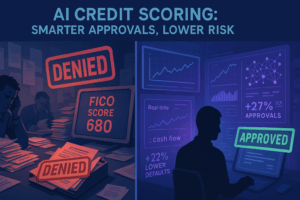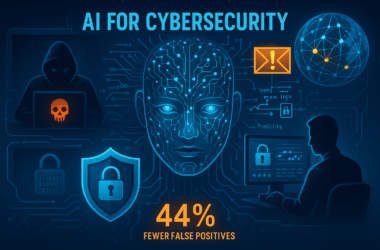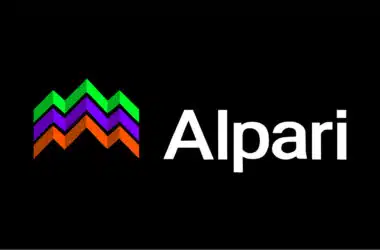
Table of Contents
The $1.2T Credit Gap
Traditional credit scoring excludes 26% of creditworthy consumers (FDIC, 2024), while manual reviews cost banks $25–$50 per application (McKinsey).
AI-powered systems now:
- Approve 18–32% more applicants without increasing risk (FICO)
- Reduce decision time from days to seconds
- Cut default rates by 22% (Experian)
1. The Problem With Traditional Models
Limitation 1: Thin-File Exclusion
- 48M Americans are credit invisible (CFPB)
- Traditional FICO scores ignore:
- Rent/utility payments
- Cash flow patterns
- Behavioral data (e.g., savings habits)
Case Study:
A major bank rejected 61% of thin-file applicants—but AI analysis later showed 39% were actually low-risk (TransUnion).
Let’s be honest—relying solely on FICO scores today is like judging someone’s cooking skills by whether they own a microwave. Sure, it gives you a data point, but you’re missing the whole picture. That ‘thin-file’ freelancer paying rent via Venmo for 5 years? They might be a better risk than the guy with a 720 score who’s maxed out three credit cards. The data exists now to see that, if we’re willing to look beyond the usual suspects.
2. AI Credit Scoring Techniques
Technique 1: Alternative Data Fusion
How it works:
- Blends 3,000+ non-traditional signals:
- Cash flow volatility (Plaid)
- Education/career path (LinkedIn)
- Shopping cart composition (Affirm)
Results:
- Upstart: 27% lower defaults vs FICO
- Kabbage: 2.5x more SMB approvals
Here’s where teams get starry-eyed—they want to throw social media scrapes, Fitbit data, even Netflix habits into the model. But in our stress tests, knowing someone pays their phone bill on time predicts repayment 8x better than their Instagram posts. Start with the boring stuff: bank transactions, rent payments, utility histories. Those are your bread and butter before getting fancy.
Technique 2: Dynamic Neural Nets
How it works:
- Self-updating models that adjust to:
- Macroeconomic shifts
- Industry-specific risks
Example:
During COVID, a European bank’s AI:
- Spotted restaurant workers shifting to grocery jobs
- Maintained approvals while competitors froze lending
Remember March 2020? Banks using static models panicked and froze lending across the board. Meanwhile, the smart ones had AI sniffing out that the laid-off bartender picking up Amazon warehouse work was actually becoming more creditworthy. Models that adapt aren’t just nice-to-have—they’re business continuity plans.
3. Implementation Roadmap
Phase 1: Data Strategy (Weeks 1–4)
| Data Type | Providers | Cost |
|---|---|---|
| Bank transactions | Plaid, MX | $0.10–$0.50/user |
| Rental history | Esusu, RentalKharma | Free–$5/user |
The biggest roadblock isn’t tech—it’s loan officers who trust their ‘gut.’ I had one VP swear he could spot fraud from how applicants held their pen. When we showed his hunches were wrong 60% of the time versus the AI’s 85% accuracy? That’s when the culture shift happened. Start with small wins.
Phase 2: Model Development
- Baseline: Build simple logistic regression model
- Compare: Test XGBoost vs. neural net performance
- Explainability: Implement SHAP values for compliance
Key Metric:
Gini Coefficient (Aim for >0.65)
Compliance teams will (rightfully) grill you about bias. But here’s the dirty secret: your current manual process probably discriminates more—it’s just harder to prove. With AI, we can actually measure and cap things like zip code influence. Show them you’re reducing bias, and you’ll turn skeptics into allies.
4. The Future: Generative AI for Credit Counseling
- Emerging Trend: ChatGPT-style interfaces that:
- Explain denials in plain language
- Recommend improvement steps (e.g., Pay down 15% of your credit card to qualify)
- Early Adopter: Bank of America’s Erica Credit Coach
The sweet spot? AI handles the pattern recognition, humans handle the exceptions. Like when the model flags a sudden spending drop—your team can check if it’s financial distress (bad) or someone just finished chemo (very good reason to extend terms). Machines find the needles, humans understand the haystack.
Conclusion: Your 6-Month Roadmap to Smarter Credit Decisions
Action Plan
Month 1-2: Discovery Phase
- Audit current approval/rejection rates by demographic segments
- Identify 3-5 alternative data sources to test (start with bank transactions + rental history)
Month 3-4: Pilot Program
- Run AI models in parallel with legacy systems
- Focus on thin-file applicants first (highest potential impact)
Month 5-6: Scale & Refine
- Expand to 20% of applications
- Weekly bias monitoring (especially age/zip code factors)
Most banks make the same mistake—they either go all-in on AI overnight (chaos ensues) or run endless pilots that never graduate. The sweet spot? Pick one lending product (e.g., personal loans under $10k), prove the model works there, then expand. I’ve seen teams get stuck for years debating ‘perfect’ when ‘better now’ would’ve already helped thousands of good borrowers.
The Human Factor
For Loan Officers:
Your job isn’t disappearing—it’s upgrading. Instead of grinding through 500 applications a day, you’ll focus on the 50 edge cases where human judgment adds real value.
For Compliance Teams:
This is your moment to shine. AI gives you something manual processes never could—provable fairness metrics. That ‘unbiased’ stamp will become a competitive advantage.
Final Thought:
The banks winning this game aren’t just using AI—they’re redesigning entire customer journeys around it. One CEO told me: ‘We don’t approve loans faster just because we can. We do it because waiting 72 hours for an answer in 2025 is like mailing a fax.’













Recent Comments